
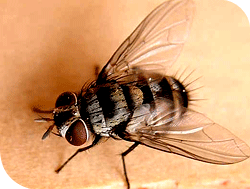
 All flies belong to the insect order Diptera, which means two wings.
All flies belong to the insect order Diptera, which means two wings.
 All flies undergo complete metamorphosis with egg, larva, pupa, and adult stages in their development
All flies undergo complete metamorphosis with egg, larva, pupa, and adult stages in their development
 Flies perform a vital function as decomposers of dead organisms, manure and decaying vegetation
Flies perform a vital function as decomposers of dead organisms, manure and decaying vegetation
 Flies may act as carriers of disease organisms present in their breeding and egg-laying sites
Flies may act as carriers of disease organisms present in their breeding and egg-laying sites
 These disease organisms can cause food poisoning, diarrhea, dysentery or typhoid fever
These disease organisms can cause food poisoning, diarrhea, dysentery or typhoid fever
BLOW FLY
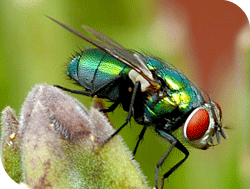
 Adult flies are metallic blue, green, copper or black colored flies that otherwise resemble house flies in appearance
Adult flies are metallic blue, green, copper or black colored flies that otherwise resemble house flies in appearance
 Common species include the greenbottle flies (Lucilia spp.), black blow fly (Phormia regina), and various Calliphora
Common species include the greenbottle flies (Lucilia spp.), black blow fly (Phormia regina), and various Calliphora
species
 Lay their eggs on the carcasses of dead animals, decaying meat or garbage that contains meat scraps
Lay their eggs on the carcasses of dead animals, decaying meat or garbage that contains meat scraps
 Large numbers of blow flies occur when a dead animal - usually a mouse or squirrel - dies within the home
Large numbers of blow flies occur when a dead animal - usually a mouse or squirrel - dies within the home
 Although such occurrences are unpleasant, they are usually short-lived and self-limiting, as the insects are only
Although such occurrences are unpleasant, they are usually short-lived and self-limiting, as the insects are only
capable of breeding on freshly killed animals
HOUSE FLY
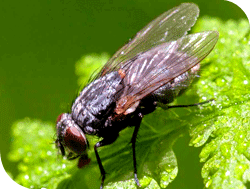
 The house fly is the most common fly pest around homes
The house fly is the most common fly pest around homes
 House flies generally are gray, with the thorax marked with four dark stripes
House flies generally are gray, with the thorax marked with four dark stripes
 Female flies lay numbers of eggs in suitable larval food sources such as decomposing food in garbage,
Female flies lay numbers of eggs in suitable larval food sources such as decomposing food in garbage,
animal excrement or other decomposing organic materials
 The adult flies feed on a wide range of liquid waste but can eat solid foods, such as sugar
The adult flies feed on a wide range of liquid waste but can eat solid foods, such as sugar
 To digest solid foods, house flies liquefy food by regurgitating it and thereby are ideally suited to
To digest solid foods, house flies liquefy food by regurgitating it and thereby are ideally suited to
mechanically transmit disease organisms such as diarrhea and dysentery, to people
STABLE FLY
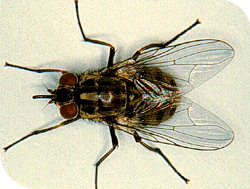
 Stable flies are also called biting house flies
Stable flies are also called biting house flies
 The stable fly is a about ¼-inch long and gray with four dark stripes on its thorax
The stable fly is a about ¼-inch long and gray with four dark stripes on its thorax
 This fly looks like a house fly, except for the pointed proboscis beneath its head through which it sucks blood
This fly looks like a house fly, except for the pointed proboscis beneath its head through which it sucks blood
 They typically bite in early morning or late afternoon and often attack the ankles, inflicting a sharp, stabbing pain
They typically bite in early morning or late afternoon and often attack the ankles, inflicting a sharp, stabbing pain
 Stable flies lay eggs in piles of rotting vegetable matter, such as haystacks, grass clippings, manure and
Stable flies lay eggs in piles of rotting vegetable matter, such as haystacks, grass clippings, manure and
vegetation along shorelines
FLESH FLY
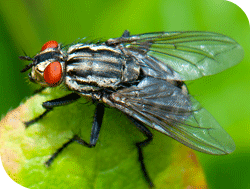
 Flesh flies are gray with three dark stripes on its thorax
Flesh flies are gray with three dark stripes on its thorax
 They are slightly larger than house flies and have a checkerboard pattern on the abdomen
They are slightly larger than house flies and have a checkerboard pattern on the abdomen
 Flesh flies are attracted to sources of decay around the home, including garbage dumpsters, compost
Flesh flies are attracted to sources of decay around the home, including garbage dumpsters, compost
piles and dead animal carcasses
 Flesh flies are helpful in forensic entomology because they are usually the first to arrive at a carcass
Flesh flies are helpful in forensic entomology because they are usually the first to arrive at a carcass
after an animal dies
 Flesh-flies can carry leprosy bacilli and can transmit intestinal pseudomyiasis to people who eat
Flesh-flies can carry leprosy bacilli and can transmit intestinal pseudomyiasis to people who eat
the flesh-fly larvae
VINEGAR FLY/FRUIT FLY
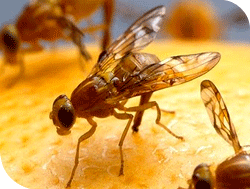
 Vinegar flies are small, slow-flying insects usually found in association with over-ripened fruit and vegetables,
Vinegar flies are small, slow-flying insects usually found in association with over-ripened fruit and vegetables,
and are sometimes inaccurately called fruit flies
 Vinegar fly adults vary from 3 to 4 mm in length, have reddish eyes, are light yellowish brown to dark
Vinegar fly adults vary from 3 to 4 mm in length, have reddish eyes, are light yellowish brown to dark
brown in colour,and may have darker markings on the dorsum of the thorax in the form of spots, blotches, or lines
 Vinegar flies are common nuisance pests in restaurants, grocery stores, fruit markets, canneries, homes,
Vinegar flies are common nuisance pests in restaurants, grocery stores, fruit markets, canneries, homes,
and other locations that may attract these insects with fermenting or rotting vegetative matter
Some of the most common house Fly diseases transmitted in the U.S. include food poisoning, dysentery, and diarrhea. These pests may also transmit the eggs of parasitic worms, which cause their own issues.
House flies can cause a huge threat to businesses, especially those operating within the food industry. Compared to other pests such as rodents and cockroaches, flies are responsible for causing the highest number of staff illnesses. But why is this?
Well, house flies (along with other species of filth flies) are known to spread a range of harmful diseases. The World Health Organization estimates that house flies are responsible for transmitting at least 65 diseases. These diseases can have an impact on both customer and staff health, resulting in damages to income, brand reputation and staff retention.
House flies are known to carry and spread these diseases:
1. Cholera
2. Conjunctivitis
3. Dysentery
4. Gastroenteritis
5. Salmonellosis
6. Tuberculosis
7. Typhoid fever
They transmit this range due to their feeding and breeding habits. House flies will often feed on rotting or decaying matter, as well as human and animal faeces. When a house fly feast upon an item of food infected with bacteria they accumulate the pathogen within their oesophagus or digestive system.
Due to a house flies feeding habit of regurgitating their stomach contents onto solid objects to liquify them, any bacteria living in their oesophagus will be transmitted to the item they are consuming. Similarly the bacteria living within their digestive system will be transmitted to items which they defecate on through their faeces.
Areas where these products are found, the items themselves, as well as their preferred breeding sites, can often play host to the pathogens which cause the diseases. Because of this house flies can accumulate the bacteria on the tiny hairs on their legs and body. When a fly lands on a food product, or any other item, any pathogen which has attached itself to said hairs can easily be transmitted.
Verminex® PEST CONTROL HAS BEEN PROVIDING EFFECTIVE SOLUTIONS FOR GETTING RID OF FLIES. CONTACT US FOR ESTIMATE FOR YOUR HOME OR BUSINESS.